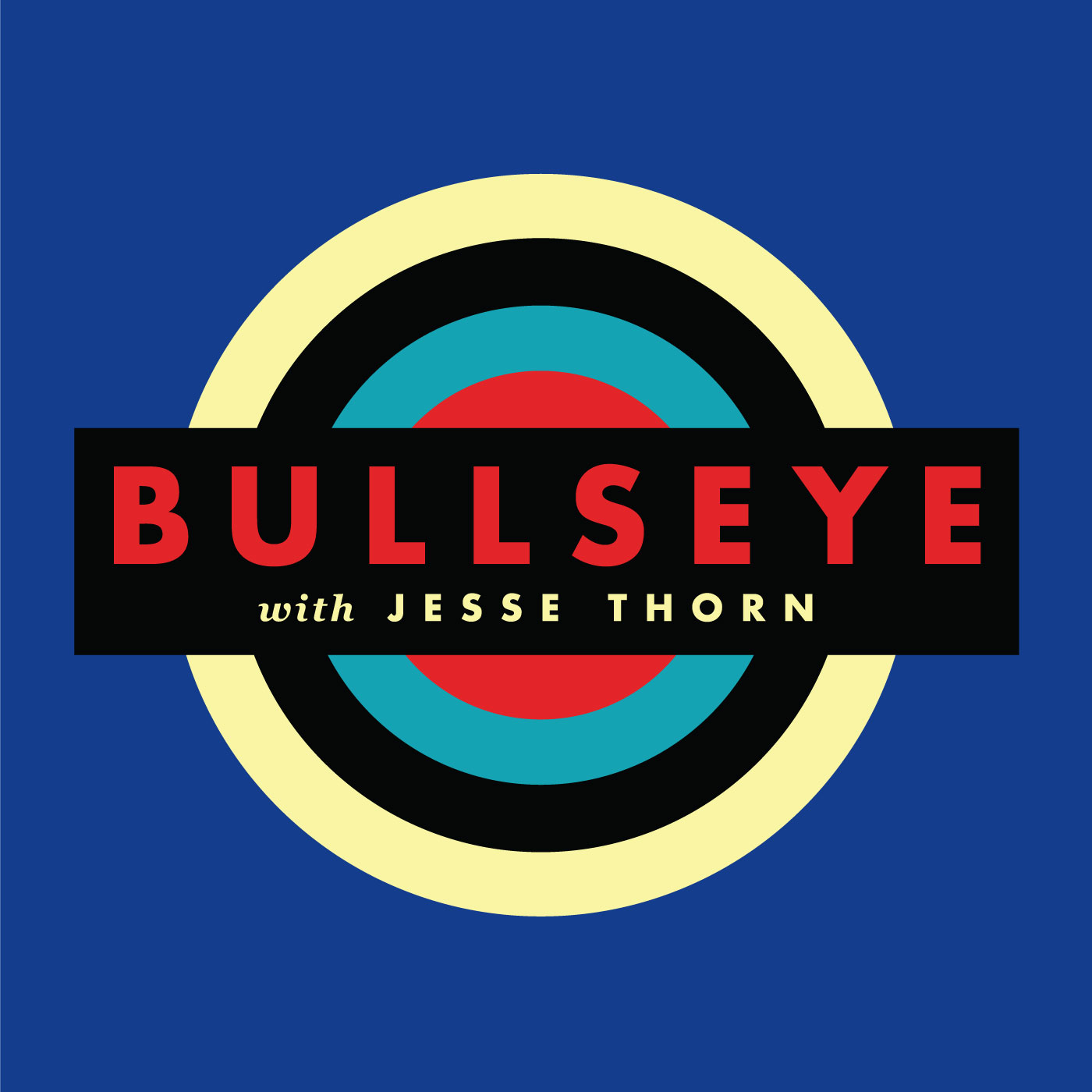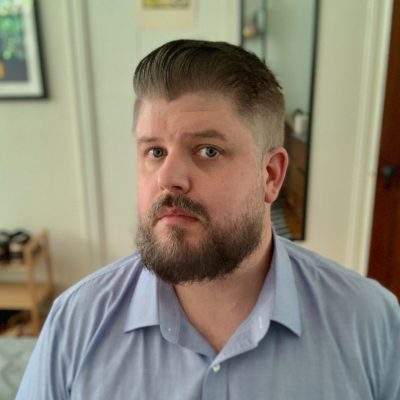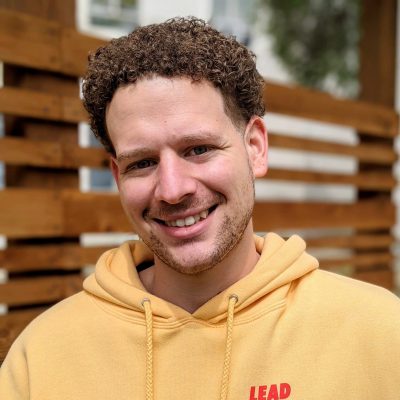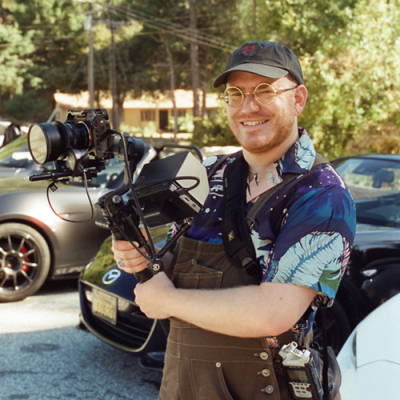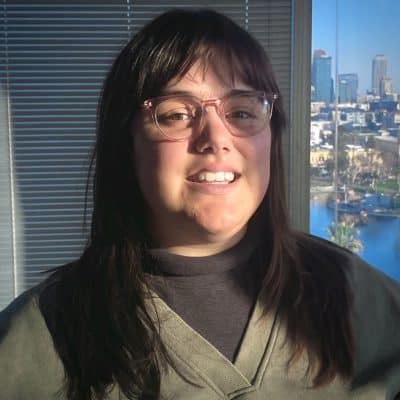Transcript

music
Gentle, trilling music with a steady drumbeat plays under the dialogue.

promo
Speaker: Bullseye with Jesse Thorn is a production of MaximumFun.org and is distributed by NPR. [Music fades out.]

music
“Huddle Formation” from the album Thunder, Lightning, Strike by The Go! Team. A fast, upbeat, peppy song. Music plays as Jesse speaks, then fades out.

jesse thorn
It’s Bullseye. I’m Jesse Thorn. Time now for The Song That Changed My Life—where we invite musicians to tell us the story behind the song that changed their life. This week, our guest is Rostam. Rostam is a singer and songwriter. He got his start as a member of the band Vampire Weekend. He produced that group’s first three records. [Music fades in.] Including some of their biggest hits.

music
“Horchata” from the album Contra by Vampire Weekend. In December, drinking Horchata Look down your glasses at that Aranciata With lips and teeth to… [Volume decreases and continues under the dialogue then fades out.]

jesse
Rostam left the band in 2016—not just to go solo, but to change things up and diversify his work. He collaborated on a record with Hamilton Leithauser of The Walkmen in 2016. Followed that up with his first solo record and produced the acclaimed Haim record, Women in Music Pt. III.

music
“3 AM Lyrics” from the album Women in Music Pt. III by Haim. Now you’re calling 3AM, my head is spinning Pushed off the sheets from my bed ‘Cause the phone keeps ringing All I keep thinking is have I lost my mind? [Volume decreases and continues under the dialogue then fades out.]

jesse
This summer, Rostam released his second solo album; Changephobia is a laidback, romantic pop record.

music
“Next Thing” from the album Changephobia by Rostam Batmanglij. I was a sucker a long time ago I ain’t a sucker, though Not anymore That’s what they all say You’re just as bad as them [Volume decreases and continues under the dialogue then fades out.]

jesse
When we asked Rostam about the song that changed his life, he picked a Paul Simon song. It’s called “The Coast”. “The Coast” is a track from Rhythm of the Saints, which Simon released a few years after Graceland. A lot of critics consider Graceland to be Simon’s masterpiece, but—as Rostam tells it—“The Coast” is a much more rewarding listen. [Music fades in.] Okay, here we go. Rostam on the song that changed his life.

music
“The Coast” from the album The Rhythm of the Saints by Paul Simon. [Volume decreases and continues under the dialogue.]

rostam batmanglij
Hi, I’m Rostam and this is the song that changed my life.

music
[Volume increases.] [Volume decreases and continues under the dialogue.]

rostam
The first time I heard this song, I must have been eight years old. It was 1991 and this was one of the CDs that my parents would play in our kitchen, in our living room. I would even hear it sometimes in assembly in middle school. So, it was something that was both in my house and kind of in my school.

music
[Volume increases.] This is a lonely life Sorrows… [Volume decreases and continues under the dialogue.]

rostam
My parents would play music pretty obsessively and it would often go into these heavy rotations, where one album was just always on in the kitchen. And the kitchen was where my mom would be testing recipes. My mom’s a cookbook author, so she would always be testing recipes and always trying to improve her recipes, whether they were in print yet or not. This was one of those albums that was always playing in the kitchen. Another one was the Yo-Yo Ma, Bobby McFerrin collaborative album.

music
“Hush Little Baby” from the album Hush by Bobby McFerrin and Yo-Yo Ma. [Volume decreases and continues under the dialogue then fades out.]

rostam
Another one I can remember is the Big Night soundtrack. [“Mambo Italiano” fades in.] Big Night, the Stanley Tucci movie.

music
“Mambo Italiano” from the album Big Night by Buddy Cole, Rosemary Clooney, and The Mellomen. Go, go, go you mixed siciliano All you calabrese do the mambo like a crazy with a Hey mambo… [Volume decreases and continues under the dialogue then fades out.]

rostam
But between those three albums was probably most of the music that I heard as a child.

music
“The Coast” from the album The Rhythm of the Saints by Paul Simon. [Volume decreases and continues under the dialogue.]

rostam
When I listen to Rhythm of the Saints, I’m reminded of being in my living room in DC, where I grew up. My dad had these two KEF speakers that were about ten feet apart from each other. And I just remember experiencing a feeling like I was inside the music. And I feel like this album—Rhythm of the Saints—in a way that’s very special and unique, it captures the sound of people playing music together in a room. And it captures the energy of that and the vibe and probably, most especially, the groove of people playing together. Lots of people playing together.

music
[Volume increases.] And that’s worth something When you think about it That is worth some money That’s worth something When you think about it That is worth some money A trip to the market A trip into the pearl grey morning sunlight That settles over Washington A trip to the market [Volume decreases and continues under the dialogue.]

rostam
As a kid growing up in DC, whenever I heard that lyric, “the pearl grey light that settles over Washington”, I… I really did think he was singing about DC. And I never thought it was Washington State. For me, it was—it was always this interesting connection that was connecting this specific Paul Simon song back to where I grew up. And I think now—as somebody who hasn’t, you know—I’m 37 and I haven’t lived in DC since I was 18 years old. Whenever I listen to this song, I think back to my childhood and think back to DC. And I think there is a very specific light in DC. And I—you know, I think “pearl grey” is maybe [chuckles]—maybe the exact combination of words to describe the light in Washington DC.

clip
[The roar of a crowd.] Music: Upbeat, brassy music. Speaker: It’s Saturday Night Live! Musical guest, Vampire Weekend!

rostam
In 2008, Vampire Weekend played Saturday Night Live for the first time.

clip
Amy Adams: Ladies and gentlemen, Vampire Weekend! [The crowd cheers.] Music: “A-Punk” from the album Vampire Weekend by Vampire Weekend. [Volume decreases and continues under the dialogue.]

rostam
And I remember looking at our drummer, Chris Tomson. And he pointed up to the rafters, where the audience sits at SNL, and there was a guy in a baseball hat. And he looked sort of familiar, but I couldn’t tell who that person was. But Chris started mouthing [laughing] the name Paul Simon. And pretty soon, I realized that he was right, and it was Paul Simon.

clip
[Volume increases.] … seen the thing In the young men’s wing at Sloan-Kettering [Volume decreases and continues under the dialogue then fades out.]

rostam
In about an hour’s time, we had finished our rehearsal. We were eating dinner before the show. And Paul Simon was sitting at our table with us. And I remember [laughs] asking him about Rhythm of the Saints. [“The Coast” fades back in.] But really, telling him how much I loved that album. And I think it—you know, his response was sort of about how it was a difficult album for people to get into. And I think—I think he also felt like some of the things that were happening, rhythmically, on the album were maybe too complex. That a lot of people could really digest the rhythms. But Paul—I remember, Paul Simon also said something about the critics He said something like, you know, “The first hit is free.” Like, they’re drug dealers. [Laughs.]

music
“The Coast” from the album The Rhythm of the Saints by Paul Simon. Summer skies, the stars are falling [Volume decreases and continues under the dialogue.]

rostam
This is a moment that’s just drums. And I love—I love that about this song. I love any song that’s not afraid to break down to just drums. I think that’s something that is maybe one of the things that I do a lot, as a producer—in my own music and music that I make with others—is I love to hear drums just grooving for a while. To me, there is something about what’s going on musically, on this album—Rhythm of the Saints, that—it does represent like so much of what I’m interested in in music. The way that the guitar and the bass interlock, the way that the drums—even if you just listen to the drums and tune out everything else, the drums are constantly speaking to each other. The left channel to the right channel and back again. There’s a lot of interaction. And there’s this creation of a wide space where, you know, you’re really using the left and the right speaker to create an immersive experience. And the more that I work as a producer, the more that I learn about how that space can really alter your perception of the music being alive. It’s something that I—you know, since the first record I ever made when I was 22, it was in my mind. It was in the back of my mind. I understood how powerful it was to pan things to the left and to the right and have them interact with one another.

music
[Volume increases.] [Volume decreases and continues under the dialogue.]

rostam
This album is an example of an album that’s doing it—it is a live recording. It doesn’t sound like a multitrack recording. It sounds like the people are playing the music together and what you hear is a function of their collaboration.

music
“Cape Cod Kwassa Kwassa” from the album Vampire Weekend by Vampire Weekend. [Volume decreases and continues under the dialogue.]

rostam
Rhythm of the Saints was definitely—it was a album that I had had on my computer and had revisited at different times. But around 22, I did kind of rediscover it again. And I remembered when we had started recording “Cape Cod Kwassa Kwassa”, it was a really—originally just, you know, the rock drums, guitar, bass, organ. And I took it down to my friend, Jeff Curtin, and Jeff had a hand drum. And he had a bunch of shakers. And I had a few ideas for what he could do. And I asked Jeff to play hand drums on “Cape Cod Kwassa Kwassa”. And then I think it was a little controversial when I bounced down the first mix of “Cape Cod Kwassa Kwassa” and the hand drums were like about ten DB louder than the rock drums.

music
[Volume increases.] Is your bed made? Is your sweater on? Do you want to Like you know I do Like you know I do [Music fades out.]

music
“The Coast” from the album The Rhythm of the Saints by Paul Simon. [Volume decreases and continues under the dialogue then fades out.]

rostam
I think a lot of my sense of rhythm was informed by this album. And “The Coast” is an example of probably like one of my favorite grooves.

music
[Volume increases.] We are standing in the sunlight The early morning sunlight In the harbor church of St. Cecilia To praise… [Volume decreases and continues under the dialogue.]

rostam
I think this song is about traveling. I think it’s about traveling and it’s maybe about leaving your mistakes behind you. And maybe that’s the injured coast that he’s singing about, is our past and the things that we might regret having done.

music
[Volume increases.] … blind me now Summer skies, stars are falling All along the injured coast Oh-wah, oh-wah Doo wop a doo wah The summer skies, the stars are falling Leaving the shadow of the valley behind me now [Volume decreases and continues under the dialogue.]

rostam
I love the riff that Paul Simon sings on that line “leaving the shadow of the valley behind me now”. That lyric has never appeared in the song before and it’s coming at this incredibly important moment where he introduces a new lyric and a new melody and it’s those kind of moments in songs that I feel like are what I’m always searching for when I’m—when I’m working on music. I want it to feel like a complete thought. And I think it can’t just be one thing. It can’t just be new lyrics. It can’t just be a new melody with old lyrics. It’s gotta be those two things happening together at the same time and in the right moment. And I think that line, “leaving the shadow of the valley behind me now”, that’s an example of that perfect moment where a song really lets you know that it is a complete thought and it’s telling you a whole story.

music
[Volume increases.] Leaving the shadow of the valley behind me now [Volume decreases and continues under the dialogue then fades out.]

rostam
So, “leaving the shadow of the valley behind me now” is saying I’m letting go of these mistakes that I made. I don’t know. That’s one interpretation. Who knows? Who knows what it’s about, exactly?

jesse
Rostam. You just heard him telling us about the song that changed his life: “The Coast” by Paul Simon. Rostam’s new album is called Changephobia. You can stream it or buy it at your local record store. [“4Runner” fades in.] Let’s go out on one more track from that album. This one’s called “4Runner”.

music
“4Runner” from the album Changephobia by Rostam Batmanglij. First time, they took me down I went down swinging Second time, I didn’t put up a fight I take the keys down from the hook I pick you up from work We stick to the straight roads up the West Coast And I feel a part of me slide When the trucks drive by I feel ‘em sway us side-to-side You’re underneath a blanket on the backseat I’m going station to station on the dial Don’t wanna be pretty like a girl I think I’m pretty much your boy You wear a baseball cap all the time [Volume decreases and continues under the dialogue.]

jesse
That’s the end of another episode of Bullseye. Bullseye is created from the homes of me and the staff of Maximum Fun, in and around greater Los Angeles, California. Here at my house, I bought a mango tree at the farmer’s market, and I just planted it in my backyard. And, uh, we’ll see how mangos grow in my backyard, I guess. The show is produced by speaking into microphones. Our senior producer is Kevin Ferguson. Our producer, Jesus Ambrosio. Production fellows at Maximum Fun are Richard Robey and Valerie Moffat. We also get help from Casey O’Brien. Our interstitial music is by Dan Wally, also known as DJW. Our theme song is by The Go! Team. Thanks to them and to their label, Memphis Industries, for sharing it. They’ve got a great new record out that you should check out. You can also keep up with our show on Twitter, Facebook, and YouTube. We post our interviews in all of those places. And I think that’s about it. Just remember: all great radio hosts have a signature signoff.

music
[Volume increases.] … the stolen plates Long, long gone Take off a shift… [Volume decreases and continues under the dialogue.]

promo
Speaker: Bullseye with Jesse Thorn is a production of MaximumFun.org and is distributed by NPR. [Music fades out.]
About the show
Bullseye is a celebration of the best of arts and culture in public radio form. Host Jesse Thorn sifts the wheat from the chaff to bring you in-depth interviews with the most revered and revolutionary minds in our culture.
Bullseye has been featured in Time, The New York Times, GQ and McSweeney’s, which called it “the kind of show people listen to in a more perfect world.” Since April 2013, the show has been distributed by NPR.
If you would like to pitch a guest for Bullseye, please CLICK HERE. You can also follow Bullseye on Twitter, YouTube, and Facebook. For more about Bullseye and to see a list of stations that carry it, please click here.
Get in touch with the show
People
How to listen
Stream or download episodes directly from our website, or listen via your favorite podcatcher!
